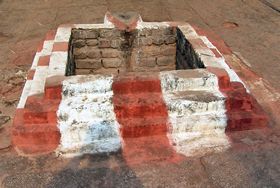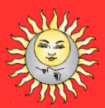

Shaktanandatarangini Abstract
Only if conjoint with the Shakti would Shiva earn the privilege to become overlord; otherwise the God is not able even to stir. While so, how dares one, who has acquired no merit, either to salute or to praise Thee, who are worthy of being adored even by Hari, Hara, Virincha and others? - Saundarya Lahari, IThis compilation - waves of bliss for Shaktas, devotees of Shakti, is ascribed to Brahamandagiri, with the edition used for this abstract being volume two of the Yogatantra Granthamala, published by Sampurnanand Sanskrit University, Varanasi, 1987.
The text is made up of eighteen chapters, called here Ullasas, which range far and wide across many tantrik themes. It is notable for referring to other authorities, some of which aren't available now.
The first chapter deals of the body. including the characteristics of the five elements, the vital breaths in the body, the place of the nadis or conduits of prana, where the planets are in the body, and the process of birth.
Chapter two deals with initiation, the nature of the guru, the suitability of a female partner, and closes with the greatness of the guru.
The third chapter deals with the nature of the absolute with both forms and without forms. The 58 shloka chapter also discusses the various avatars of Vishnu, such as Matsya, Kurma, Varaha, Nrisimha, Vamana, Rama, Buddha and Kalki.
In chapter four there's a description of the acts to be performed in the morning including meditation on the Kundalini and the six chakras, meditation in the 1000 petal lotus, cleaning of teeth, bathing, wearing clothes and tilaka, and the characteristics of the Gayatri mantra.
Chapter five relates to recitation of mantra (japa), the characteristics of the seat upon which to do meditation, and puja during the day and the night.
In chapter six, there are quotations from texts about inner worship (antaryaga) and outer worship (bahyapuja) and also information relating to bhutashuddhi.
Chapter seven talks about daily puja, how to cleanse and purify the place of worship, more on bhutashuddi, as well as information about Matrika Nyasa related to pranayama. There's more information about other nyasas such as shodha and hand and limb nyasa, with the chapter closing with avarana puja.
In chapter eight, there is discussion on the various malas (rosaries) to be used in puja, including the characteristics of rudraksha malas, how to place them, and the correct way to use malas when pronouncing mantras.
Chapter nine deals with the rules of reciting mantras, the essence of mantra, the real meaning of mantras, and the consciousness inherent in mantras. There's a discussion about the yoni mudra.
In chapter 10, there is a string of code words given in association with numerous aspects of the Devi - the commentary gives their meaning. This chapter refers to these as setus or bridges, and refers to tantras that appear to be lost, such as Setumangala Tantra, Mahasetumaha Yamala, and others. Sundari, Bhairavi, Tara, Shyama, Bhuvaneshi, Annadaya (Annapurna), Mahishamardini, Vishnu, Krishna, Rama, Shiva, and others are described. A mantra for kavacha (magical armour) is described, followed by Kukkula mantras for many devatas.
Chapter 11 gives a number of mantras for purifying the mouth for many of the devatas described in the previous chapter. It gives the rules relating to light, and concludes with the Yoni mantra, quoting from a Yamala. This, it says, is the great Kamakala mantra, made famous by Mahakala himself.
In chapter 12, there's a description of purashcharana, the preliminary acts that must be undertaken for a mantra to become fruitful, as well as a description of the types of food to be eaten and to be avoided. Kshetrapala must be worshipped. The correct resolution must be adopted. It gives the rules of homa. The number of times mantras must be recited are related.
Chapter 13 deals with the construction, purification and creation of yantras. The devata cannot be worshipped without yantra. The different materials it may be made of, such as gold, silver or copper, crystal etc. are enumerated. The compilation quotes from the Urvhamnaya Tantra saying that just like mantras need to be purified, so too do yantras. Yantras need to be bathed, to be anointed with the five gavyas. Methods for installing life in yantras and the sacrifices to be made are discussed.
In chapter 14, there's a description of the offerings (upachara) to be made in worship, including the different scents, flowers, foods and lights.
Chapter 15 opens with a quotation from the Kulachudamani Tantra and immediately goes on to discuss the Kula Trees. A number of different sources give slightly different lists. Then the great pithas of Shakti are described - the text quotes lists from the Gandharva Tantra and the Yoginihridaya Tantra. Feeding jackals is described, with the compilation quoting works including the Visvasara. Mantras to be used when feeding jackals are described.
In chapter 16, the various results to be expected from reciting mantras and the like are mentioned, as well as the various faults that can mess everything up. Prescriptions to avoid some of these are given.
The 17th chapter describes the pavilions and kundas (fire hearths) to be used in worship. These can be of different shapes and dimensions, which are also described in the text. The last Ullasa, 18, dilates further on homa using such kundas and the rites, including various nyasas, that need to be performed.
Artwork is © Jan Bailey, 1996-2018. Translations are © Mike Magee 1996-2018. Questions or comments to mike.magee@btinternet.com
Home Page